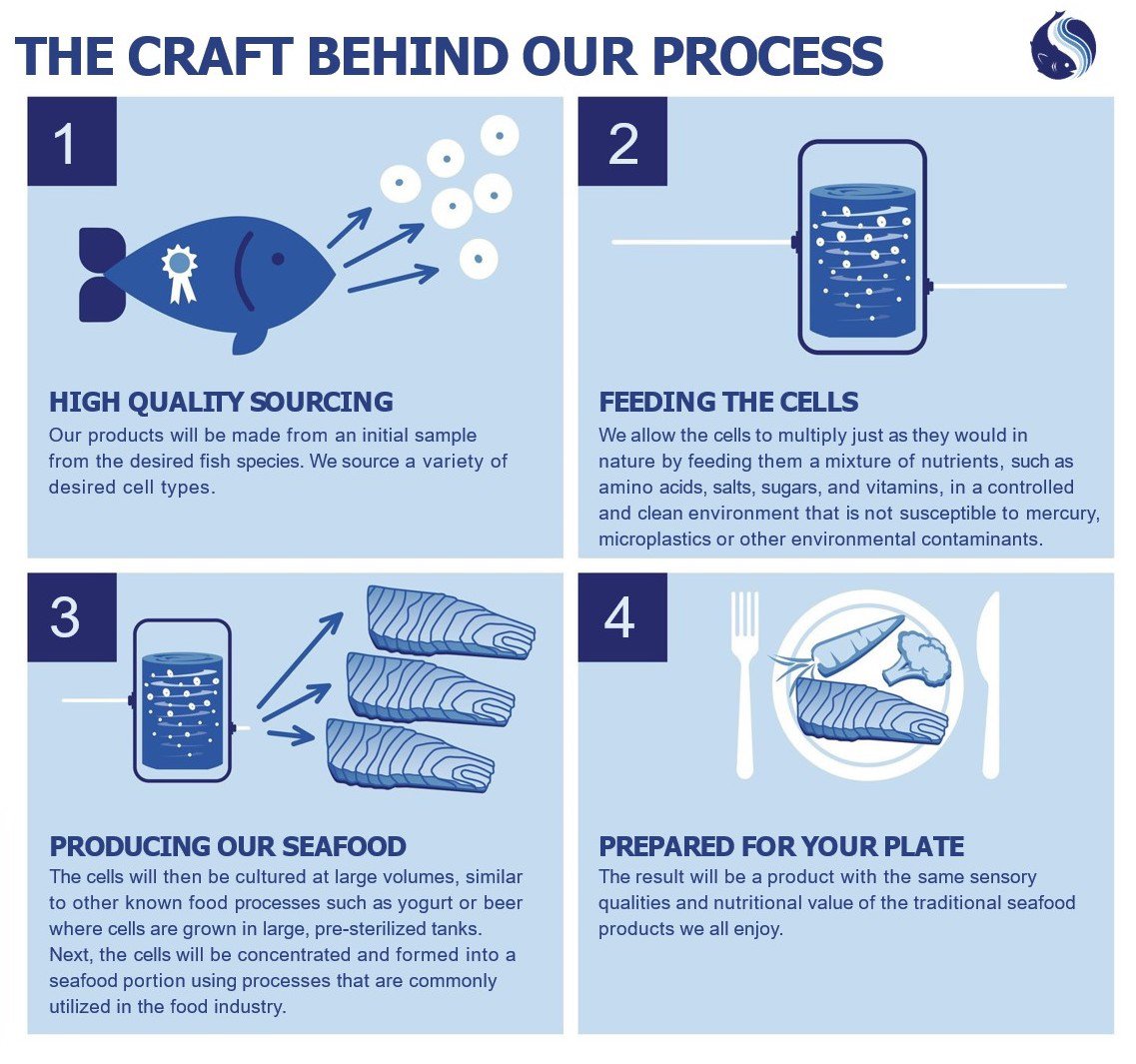Food Technology Magazine | Innovation
Oceans of Innovation
BlueNalu founder and CEO Lou Cooperhouse has been riding the wave of food industry innovation for more than 40 years and says his latest venture will produce a sea change in the seafood category, for consumers worldwide, and for the planet.

BlueNalu founder and CEO Lou Cooperhouse. Photo by Matt Furman
Lou Cooperhouse has ridden a tidal wave of firsts in the food innovation space over the past 40 years. At Campbell Soup, back in the early 1980s, he led operations for a brand called Today’s Taste, which was the nation’s first test-marketed complete line of refrigerated prepared foods sold at retail. Products in the line, which included entrées, salads, soups, and desserts, were even store-to-door-delivered to an end-aisle kiosk that was quite novel at that time. Later, at a Nestlé and venture-funded startup called Culinary Brands, Cooperhouse advanced his disciplined R&D process that integrated culinary arts and food science in one of the earliest applications of “culinology.” At Culinary Brands, the first company in America to develop and commercialize an industrial process for sous vide, he served as vice president of technical services. In the 1990s, he focused his interests on health and wellness, and was cofounder, president, and chief operations officer for MenuDirect, an innovative company that created meal solutions never before developed for consumers with diabetes, celiac disease, PKU, and dysphagia.
On the business side of innovation, Cooperhouse co-founded and served as executive director of the Rutgers University Food Innovation Center, the first incubator of its kind worldwide, and one that has received numerous awards for the specialized services it has provided to food entrepreneurs over the past 20 years. He also created FoodBIN (Food Business Innovation Network) as the first-ever global association of business incubators and innovation centers.
And while all these firsts and many other accomplishments have been rewarding, Cooperhouse says that taking the helm at BlueNalu, the startup cell-cultured seafood company he created nearly six years ago, is a first-wave opportunity in an ocean of innovation opportunities that may just top them all.
“This is unlike anything I’ve done to date or, arguably, that almost any innovator in this universe has really taken on,” says Cooperhouse. “What we’re talking about is an industry that has not changed much in millennia, especially in the ways we harvest seafood from the wild, as these use inefficient and extraordinarily environmentally taxing practices. The opportunity to solve the challenges of today and tomorrow with cell-culture technology that is healthy for people, humane for sea life, and sustainable for the planet is incredibly exciting. With BlueNalu, we can replace today’s highly variable and supply-restricted seafood supply chain with one that will be vertically integrated, consistent, and delicious every time.”
Since its launch in 2018, San Diego–based BlueNalu has received total funding of more than $100 million from investors in more than 14 nations, including several multinational food companies. Recently, the company expanded into its 38,000-square-foot pilot facility and innovation center with a focus on production of premium bluefin tuna toro—the high-value fatty part of the fish found in the belly—and is now completing the processes required for regulatory review.
In just five years, BlueNalu has developed technologies that are scalable, and that when married with higher-value species like bluefin tuna, can result in a superior value proposition for consumers and extraordinary profitability for the company, Cooperhouse says. He is especially proud of the company’s ability to fast-track breakthrough technologies, including a non-genetically modified organism (GMO), single-cell suspension line with high growth rates to accelerate the company’s scale-up to large bioreactors and a revolutionary lipid-loading technique to create final products with higher fat profiles and sensory attributes. BlueNalu plans to build its first large-scale facility over the next few years, which has been designed to produce up to six million pounds of premium seafood products annually, utilizing eight 100,000 liter terminal bioreactors.
Food Technology caught up with Cooperhouse to find out more about the new world of innovation that is culture-based seafood, and the revolutionary sea change he envisions is the next big thing to benefit people and the planet.
As a food industry innovator for more than 40 years, how do you define innovation and why?
I see innovation as a two-step process. First, it begins with identifying a food opportunity in which you can create a superior value proposition that is truly differentiated and provides unique benefits, and then accomplishing this with an innovative process. This innovative process is the second step and is about a certain mindset. I’ve been an early proponent of open innovation, meaning that ideas come from all over the universe. It’s not what you know, it’s knowing what you don’t know and trying to embrace all that is possible. And that means not just in your industry, but all that is possible in other industries that can be perhaps leveraged or transferred to your industry.
It’s really having an open mind and wide lens on what is possible and enabling yourself and your team to think outside the box and identify ways to integrate all these wonderful ideas to make that unique selling proposition.
What led you to found and take the helm at BlueNalu?
The Rutgers Food Innovation Center, which I co-founded and where I was executive director for 15 years, served as an interesting lens for me to see literally over a thousand opportunities and pitches about new food concepts that addressed new trends and utilized new forms of science and technology. For example, our facility in New Jersey was the location at which Impossible Foods first commercialized their plant-based burgers. During my time at Rutgers, I felt like I was there at the very beginning of the entire category of alternative proteins, as this first took shape about 10 years ago.
In fact, 10 years ago in 2013, a demonstration of making real meat through a cell-culturing process was the first proof of concept of what was, in my opinion, a holy grail opportunity. I saw a huge opportunity, as this technology enabled the production of real animal products and not imitation ones, but without the animal and resulting in just the part that consumers eat—with no heads, tails, bones, or skin. But my fascination was to not utilize this technology to create meat or poultry products, but instead I immediately saw the opportunity to apply this to seafood, as here we can make a truly superior value proposition versus the conventional wild or farmed seafood counterpart that exists today. With this technology, we can make seafood that could be consistent every time, be absent of environmental pollutants, and offer an extraordinary new solution for consumer and foodservice operators.
In 2017, I was a keynote speaker at a food industry conference in Hawaii, and talking about how we were in the middle of the Pacific Ocean, literally, where the great majority of our seafood supply chain comes from. My objective was to try to motivate entrepreneurship out of that audience. I presented several new technologies with the potential to create change and benefits for industry and consumers, but I specifically highlighted cell-cultured seafood and what an amazing opportunity that could be. Sure enough, I connected at the conference to a venture capital source. Given the tremendous benefits that cell-cultured seafood could bring to consumers worldwide, I became quite motivated to become an entrepreneur once again, and I went into “stealth mode” to study this further.
Has it been as challenging as you thought it would be when you got into it six years ago?
True to my nature, the first thing I did was to ask my favorite question: What do I know, and what don’t I know, and what are the challenges that need to be overcome? I quickly identified the tremendous hurdles that needed to be overcome with cell-cultured seafood, and there were many! I learned that no scientist had ever successfully created a cell line with a commercial fish species at that time, as the entire knowledge in this category existed solely with mammalian cells. No food-grade supply chain existed for the media/feed that would be required for cell growth. No large-scale process had ever been developed for this industry, as the existing process was totally pharma-focused and based on very small volumes. And, of course, there was no consumer familiarity whatsoever with this process or product. Even if all these processes could be figured out, there was also a huge external challenge, as no regulatory pathway existed anywhere in the world in which these products could be sold.
Since the company’s founding, we have successfully knocked down each of these hurdles. We have developed a scalable technology that we feel will also result in global consumer adoption, since we do not use GMOs, scaffolds, or microcarriers. We have developed a food-grade supply chain, along with an animal component–free media composition. We have conducted a third-party techno-economic analysis that identifies the pathways in which we can be extremely profitable, even if priced at parity to our conventional counterparts, as we are focusing on high-value products such as bluefin tuna toro. And, our huge external challenge, gaining regulatory approval, is no longer a challenge either, since the United States and Singapore have developed methodologies for enabling approval of these products over the past few years, and many more nations are in the process of developing this as well.
There are a lot of challenges for any newcomer to this space, but the upside to cell-culture technology is the superior value proposition of this process. We’ve come a very long way in the past five to six years, and feel we are quite differentiated globally from our peers, due to the scalable technology we’ve developed, the superior value proposition we will be able to create with high-value products like bluefin tuna, and the tremendous profitability we feel is attainable that results from the combination of these factors.
Would it be fair to say that you’ve solved for scale regarding the technological and marketability challenges of cellular aquaculture?
There are indeed two foundational issues that needed to be solved, and we feel that we have indeed solved them both. First, we’ve identified scalable technologies, as I’ve already indicated. But secondly, and importantly, we’ve done consumer research that shows that people are excited and very motivated to trial these products once they are available.
We’ve found that there are two categories of people who are excited about cell-cultured seafood products, and we are thrilled to have the support of both audiences. The first are foodservice operators, who are industry influencers, that validated my early hypothesis. During our focus groups and interviews, their questions were quite telling and provocative. They asked: “Did you say your cell-cultured product can be consistent and available year-round? Do you realize I don’t have a trusted source of seafood today? Did you say bluefin tuna, which is something that is not easily accessible and much desired by my restaurant guests? Did you say 100% yield and no back-of-the-house labor required to prepare?” These foodservice operators, hailing from both sushi and fine dining restaurants, literally told us that we’re solving some fundamental problems they have today, and that our cell-cultured products will be able to create, for the first time, products that are consistent every time, available year-round, will help displace some expensive back-of-the-house labor due to our nearly 100% yield, offer superior health and sustainability benefits to their guests, and ultimately create a level of trust with a supplier that is not available today.
We’ve found similar excitement from potential consumers. We’ve done consumer research with several thousand consumers that were preselected for their frequency in enjoying seafood as part of their regular diet. When we explained our cell-culture process and resulting products to them, they were highly motivated to try our product once available, and they ranked “free from” as the most important benefits that these products will provide. Free from what? Free from microplastics, toxins, parasites, and pollutants. So, we’ve learned that people who love seafood will also be highly desirous of BlueNalu’s seafood. They are a bit more educated. They ask more questions. While they’re familiar with the amazing health benefits of seafood like high omega-3s, they also limit their consumption of seafood due to its unpredictable health challenges, like mercury and other pollutants or toxins.
So, our products can literally eliminate barriers for both the foodservice operator and the consumer. And while we’ve accomplished all the challenging fundamental technologies, we are now focused on actually scaling up the process. As a result of the technology approach and our product-market fit, we feel BlueNalu is differentiated globally from our peers.
What else excites you about the future of food innovation?
I think there is a huge opportunity for alternative proteins, especially “real” protein products that are made from the cell-culturing process and from the precision fermentation process. We’ll see many more innovations in both of these industry segments over the next one to two decades because the industry will mature dramatically as economies of scale become realized.
I’m also intrigued by many more innovations that will originate in other sectors, such as personalized nutrition, which I’ve been speaking about since the ‘90s. For example, I’m fascinated by some of the personalized health feedback we now get from our own DNA (via 23andMe, for example), and from smart watches and other monitors like those that exist in diabetes care where the user is getting instant feedback on glucose levels. Everybody is unique, whether we’re trying to diet or whether we’re trying to avoid certain products, or we have allergies, and I am very excited to see how our personal DNA, bioinformatics, and smart sensors on our body, will provide continual feedback based on our food consumption and result in solutions that can potentially dramatically improve our health and wellness.ft











